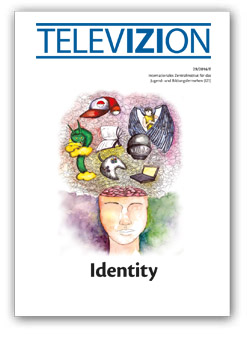|
 >> Overview publications
>> Overview publications
EDITORIAL
Personal identity means being at one with ourselves, perceiving and recognising the many different aspects of the self, and doing so in continual interaction with the world around us (Doering, vom Orde). Children and adolescents therefore face the great challenge of developing their self in negotiation with dimensions of collective identity. In this sense, they all have to find their very own way of being a girl or a boy in a world of stereotypically bipolar constructions of gender, a process of negotiation for which they use, for example, media – particularly television (Lemish). But what happens when children do not feel they belong in the traditional categories of boy versus girl (Jennings)? Borderline questions that quality television may not shy away from, as two outstanding documentaries on the subject of transgender show (Margrie, van Driel). Border areas and the interdependencies between religious and cultural identity (or better identities), such as in the case of the hijab and the meaning attributed to it by girls and young women, are addressed much more rarely (Kanso).
In order to understand – and communicate via media – these complex connections between identity, self-construction and selfportrayal, a high level of sensitivity and openness towards children and their form of self-expression is required (Jennings). Precisely when children and adolescents are faced with critical events and experiences in their lives, attentiveness and detailed basic knowledge are important (Spitzer et al.). Precisely when reporting about very critical moments of identity construction, it is important to find appropriate methods as an animation on the personal accounts of girls in a guerilla war shows (Gómez).
As current reception studies reveal, well made children’s television can contribute to children engaging with different aspects of themselves and, as with Pippi Longstocking, thinking the unthinkable (Haager). Series such as Vicky the Viking symbolically reflect the typical experiences of children and can therefore reinforce pro-social behaviours (Holler). Especially when films for adolescents (Grimm) and children’s television dare to go beyond stereotypes, as in the series Annedroids, it can be greatly enriching for identity development (Götz et al., Johnson). However, television can likewise reinforce pathogenic thoughts and behaviours, as in the case of eating disorders and the Next Topmodel format (Lahusen, Götz/Mendel).
Maya Götz
Head of the International Central Institute for Youth and Educational Television
RESEARCH
Nancy Jennings, Franziska Gruber, Stephanie
Lahusen et al.
What shapes my self
This article describes the results of an artistic activity in the context of narrative identity completed with 114 5-19 yearolds from 7 countries. The shapes created by the children and adolescents give insights in their inner worlds.
Suzanne Kanso
What does it mean for a girl to wear
a hijab?
Dafna Lemish
Boys, girls, and their media experiences
What is the role that popular culture in general, and media content for children more specifically, play in the construction of gender identity? What stories do they tell us about what it means to be a female and what it means to be a male?
Nancy Jennings
I am who I am
The article explains some of the terms used within the transgender community and developmental attributes of gender cognitions as well as examining the implications of transgender representation in contemporary media.
Maya Götz
How children negotiate their identity
development with television
Maya Götz describes the most common ways in which children use television to negotiate their identity. It highlights the opportunities but also the problems this can entail.
Maya Götz, Caroline Mendel
“So you lose weight and end up ill”
PROGRAMME RESEARCH
Julia S. Haager
What makes Pippi Longstocking a
classic of identity empowerment?
What makes the format Pippi Longstocking so strong that it has been a reference point for children’s identity issues for 70 years?
Andrea Holler
Children's identity issues in a Viking
animation
Maya Götz, Caroline Mendel,
Sophia Pritscher, Ana Eckhardt Rodriguez
Can a children's TV show change clichés?
Watching a show like Annedroids has a positive impact on children's attitude towards technology.
Jürgen Grimm
How do films contribute to shaping a
teenager's identity?
RESEARCH DOCUMENTATION
Heike vom Orde
Perspectives on identity
PROGRAMME
Carsten Spitzer, Bastian Claaßen, Arthur
Ballin, Birgit Riediger, Sigrun Bünger
How realistic is the representation?
Sandra Le Blanc, Bernadette O'Mahony et al.
What does “cultural identity” mean
for you as producer?
J. J. Johnson
Annedroids
INTERVIEW
Stephan Doering
“Identity is being at one with yourself”
Paula Andrea Arias Gómez
The girls of the war
Els van Driel
“When being transgender isn’t a taboo,
these children can more easily express
themselves”
Kez Margrie
“It was a privilege to be able
to give Leo a platform to tell
his story”
Stephanie Lahusen
Eating disorders: why do they affect
the good kids?
|




